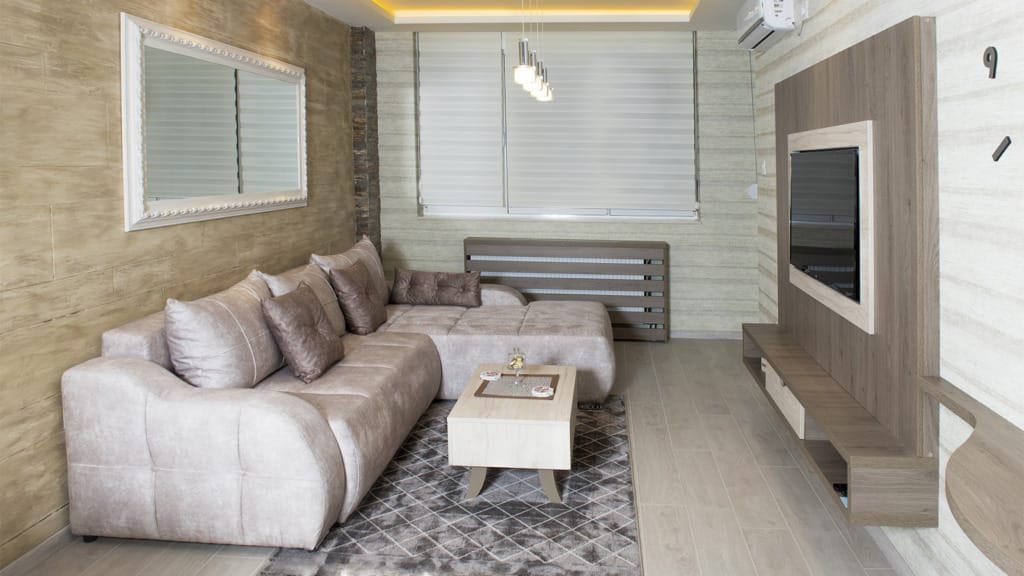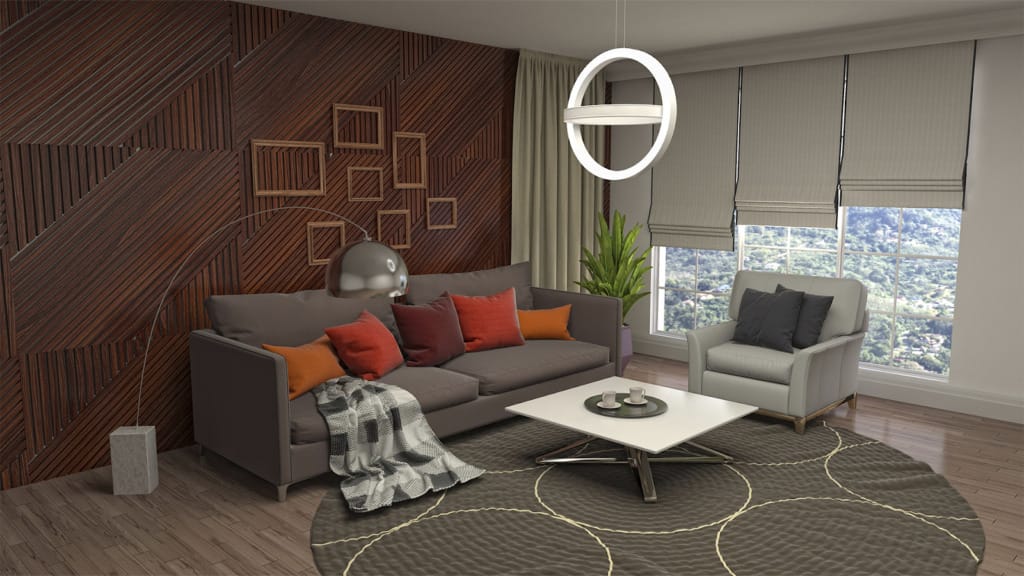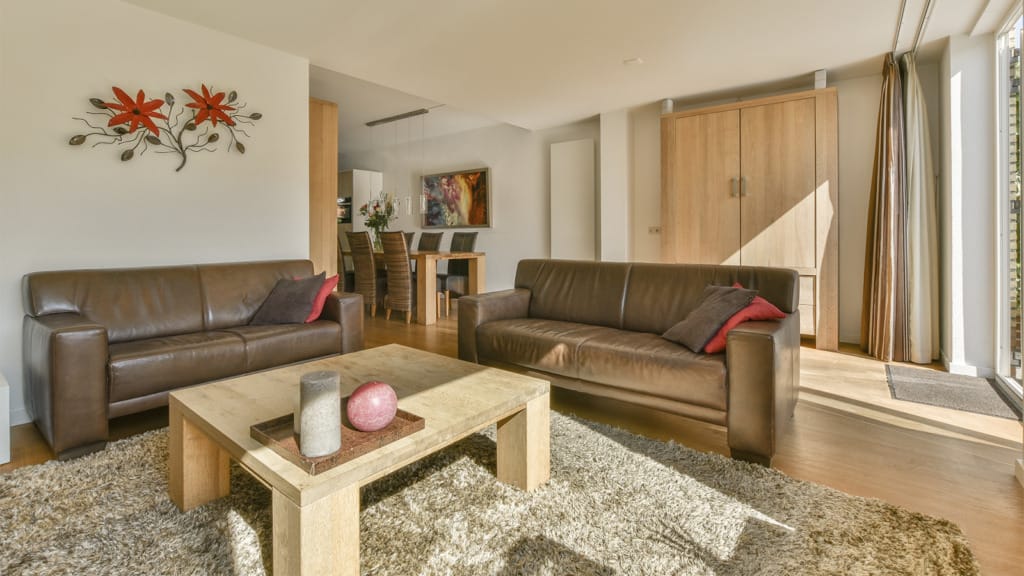If you have a living room that’s long and narrow, it can feel like you’re trying to arrange furniture in a bowling alley. You might worry there’s no way to create a cozy conversation area without blocking walkways or accentuating that tunnel‑like feel. Yet with a bit of planning and the right layout tricks, you can turn a cramped, awkward space into a welcoming retreat. This guide walks you through every step – from measuring your room to choosing furniture, establishing zones, and avoiding common mistakes, so you can create the best furniture layout for a narrow living room.
Why Narrow Living Rooms Feel Tricky & How Layout Fixes It
A long, skinny living room often looks like a runway. The door opens, and your eye is drawn straight down the length of the space. This creates a “tunnel effect” that can make the room feel uninviting and hard to furnish. Large pieces tend to hog valuable floor area, leaving cramped traffic lanes on either side. A single seating group plopped against one wall accentuates the room’s shape rather than softening it.
The good news? These problems stem from poor planning, not an inherent flaw in your home. By mapping out the dimensions, selecting appropriately scaled pieces, and dividing the room into purposeful zones, you can create a layout that solves traffic flow problems and makes the most of every inch. A well‑designed arrangement eliminates the tunnel effect, provides ample seating and storage, and invites you to linger.
Step 1: Measure & Map Your “Bowling‑Alley” Space
Before you drag a sofa across the floor for the third time, grab a tape measure and sketch a scaled floor plan. Knowing the exact length and width (including alcoves or fireplace bump‑outs) will save you hours of frustration.
- Create a simple scale drawing. Use graph paper or an online room planner to draw the room’s perimeter. Mark doorways, windows, radiators, and outlets so you know which walls are usable.
- Note traffic flow. Walk through the space and identify pathways people use to enter, exit, and move around. In narrow living rooms, a major walkway of at least 30 to 36 inches should run from the entry to other rooms. Minor pathways can be 18 to 24 inches, but should never force guests to squeeze behind chairs.
- Mark focal points. Decide whether your television, fireplace, or picture window will anchor the room. Knowing your focal point helps determine where the primary seating zone should go.
- Measure existing furniture. If you’re keeping a sofa or coffee table, note its length, depth, and height. Oversized pieces may need to be swapped for slimmer silhouettes or multifunctional options.
Taking these measurements gives you a clear view of what will fit and where. It also prevents impulse purchases that dominate the room or block doorways.
Step 2: Choose the Right Scale & Style of Furniture
Large sectional sofas and bulky coffee tables rarely work in a small, narrow living room. Instead, look for pieces that make the room feel lighter and more spacious.
- Slim silhouettes. Seek narrow sofas or love seats with low backs and exposed legs. Leggy furniture allows light and air to flow underneath, so the space feels open rather than weighed down. Consider a narrow sectional sofa with a chaise on one end; it provides plenty of seating without blocking traffic.
- Multifunctional pieces. A storage ottoman can double as a coffee table and extra seating, while nesting tables slide under one another when not in use. Folding or space‑saving furniture keeps the floor clear when you need more room.
- Vertical storage. Tall bookcases, open shelves, and wall‑mounted media consoles take advantage of vertical space and free up valuable floor area. A wall‑mounted media console keeps electronics off the floor and draws the eye upward, widening the room.
- Slim‑profile coffee tables. Choose an oval or rectangular coffee table with a narrow footprint. Glass or acrylic tables visually disappear, making the room appear larger.
- Lightweight chairs. Slipper chairs or armless accent chairs are easy to move and don’t require much clearance. Look for chairs with thin frames or open backs.
The style of your furniture should also complement the overall vibe you want to achieve. A modern or Scandinavian aesthetic with clean lines and neutral tones tends to work well in long, narrow living rooms, but you can incorporate rustic, coastal or eclectic pieces as long as they maintain a slim profile. The key is balance: avoid a heavy sofa if you want an oversized armchair, and vice versa.
Step 3: Establish Zones to Break Up the Length
One of the best ways to combat the tunnel effect is to divide your living room into smaller functional areas. Zoning creates pockets of activity and adds depth to a long space. Use rugs, lighting, and furniture placement to delineate each zone without blocking traffic.
Primary Seating Zone
This is where most conversations happen. Place a sofa or sectional facing a pair of chairs to create a cozy conversation in a narrow living room. Float the furniture away from the walls and anchor the group with an appropriately sized area rug. Make sure the rug is large enough so that the front legs of the sofa and chairs sit on it; this unifies the group and defines the space.
Secondary Lounge or Reading Nook
At the far end of the room or near a window, create a smaller seating area. A comfortable chair, pouf or chaise lounge paired with a side table and lamp makes a perfect spot for reading or quiet time. This zone breaks up the room’s length and can double as a spot for extra guests when entertaining.
Media / TV Zone
In a long living room, the television should be placed so it’s easily visible from the main seating area without dominating the entire room. Mounting the TV on a short wall helps minimize the tunnel effect; however, if your narrow space has more length than width, placing it on one of the long walls can work too. A wall‑mounted media console or slim credenza keeps electronics tidy. Keep at least 1.5 times the screen size between seating and the TV for comfortable viewing.
Entry or Walkway Buffer
Leave clear space at the entrance and maintain a pathway along one side of the room. Use a narrow console table, bench, or set of hooks to define the entry area without obstructing flow. A floating furniture layout – where furniture floats in the middle of the room with space behind it – makes traffic feel effortless.

Top 5 Furniture Layouts That Work in Narrow Living Rooms
Now that you understand zoning principles, let’s explore five specific layouts that can transform a long living room layout into a stylish, functional space.
Layout 1: Two Sofas Facing Each Other (Symmetrical Float)
This classic arrangement is perfect for narrow rooms that need generous seating. Place two slim sofas opposite each other, centered on a rectangular rug. A narrow coffee table sits in between. There should be at least 14 inches between the sofas and the table for legroom, and a clear path of 30 inches behind the sofas for easy passage. This symmetrical arrangement draws the eye toward the center rather than down the length of the room, creating a sense of balance and conversation.
Layout 2: L‑Sectional + Accent Chairs (L‑Shape Anchor)
An L‑shaped sectional can anchor one corner of a long room, providing plenty of seating without the need for multiple couches. Place the longer side along one long wall and float the shorter side perpendicular to it, leaving a walkway on the opposite side of the room. Add one or two accent chairs across from the sectional to complete the group. This layout suits spaces where the TV or fireplace is on the short wall.
Layout 3: Sofa with Console Behind & Swivel Chairs Opposite
Floating a sofa in the middle of the room, with a narrow console table behind it, divides the space elegantly. The console doubles as a place to drop keys or display decor. Opposite the sofa, place two swivel chairs angled toward each other. Swivel chairs allow guests to turn toward conversation or the TV as needed. This setup maintains an open feel and creates a natural walkway behind the sofa, perfect for a floating furniture layout.
Layout 4: TV‑Centric Galley (Fireplace & Media on Short Wall)
If your long living room ends with a fireplace or you plan to put the TV on the short wall, create a galley arrangement. Place a sofa directly across from the fireplace or TV, leaving space for a slim coffee table. Along one long wall, use a pair of armless chairs or a bench to balance the arrangement. The opposite wall can remain open for traffic or hold a console table or storage. This layout keeps the focus on the room’s focal point while still allowing conversation.
Layout 5: Split Conversation + Game or Kids Zone at the Far End
For families, dividing a long room into a formal conversation area and a casual play or gaming zone can work wonders. Near the entrance, set up a sofa and two chairs around a coffee table. Use a rug to delineate this area. Further down, place a small table with chairs for board games, homework, or crafts. Floating shelving or baskets can store toys or books. The clear line between adult and kid zones prevents clutter from spilling into the main living area while making the most of the length.
Pro Tips for Vertical Storage & Visual Tricks
When floor space is limited, go up. Vertical storage and visual tricks draw the eye upward, giving the illusion of more width.
- Install tall bookcases or open shelving. These provide ample storage without overwhelming the floor. Painting shelves the same color as the walls can help them recede visually.
- Use floor‑to‑ceiling curtains. Hang curtains as high as possible to emphasize height. Choose light, airy fabrics that filter light without blocking it.
- Add mirrors and reflective surfaces. A large mirror on one wall can double perceived space. Metallic accents and glass tables also bounce light around the room.
- Choose a vertical lighting plan. Combine floor lamps, table lamps and linear lighting like pendants to layer light at different heights. Bounce light off the ceiling with uplighting behind furniture to make the room feel taller.
- Opt for slim, leggy furniture. Furniture with raised legs allows you to see the floor underneath, creating a feeling of expansiveness.
- Use area‑rug anchoring. A rug that spans the room’s width makes the space feel larger. Make sure it’s long enough to sit under all major pieces in the zone.
Common Mistakes to Avoid When Arranging Furniture in a Narrow Room
Arranging furniture in a long, narrow space comes with pitfalls. Watch out for these common mistakes:
- Hugging furniture against the walls. Pushing everything against the perimeter can make the room feel like a corridor. Floating furniture away from walls creates a more inviting arrangement and allows you to establish zones.
- Oversized or mismatched pieces. A giant sectional may provide seating but will overwhelm a narrow space. Likewise, using furniture styles from different eras without a unifying element can create a disjointed look. Stick to a cohesive style and mix in smaller accents for personality.
- Ignoring pathways. If you have to sidestep a chair or walk through the TV viewing area, the layout isn’t working. Maintain clear walkways of at least 30 inches and plan circulation around, not through, seating groups.
- Using the wrong coffee table shape. Square tables can obstruct movement in a rectangular room. Opt for a slim-profile coffee table with rounded edges or an oval shape to ease traffic flow.
- Blocking natural light. Furniture placed in front of windows can make a room feel smaller and darker. Use low-profile or leggy pieces near windows and keep tall items away from light sources.

Quick Staging Hacks Before Photos or Showings
If you’re staging your home for sale or preparing for a photoshoot, a few quick tricks can make your narrow living room shine:
- Declutter and simplify. Remove excess furniture and accessories. Less is more when you’re trying to make a space look bigger.
- Coordinate colors. Use a unified color palette with varying shades and textures. Neutral foundations with pops of color prevent visual clutter.
- Add greenery. Plants soften corners and add life without taking up much space. Vertical planters or hanging baskets work well in narrow rooms.
- Highlight focal points. If you have a fireplace, a built‑in bookcase, or a beautiful window, arrange seating to draw attention there. Use artwork or a statement light fixture to anchor the room.
- Hide cords and clutter. Use cord covers along baseboards or run extension cords under area rugs. Keep electronics hidden in baskets or cabinets. Discreet organization can make your staging look polished.
For more professional tips, check out our article on occupied staging for sellers and learn how to tailor your home to appeal to buyers. If your living room also feels small, our post on choosing the right size furniture for small spaces explores further options.
Final Checklist & Next Steps
Before you rush to rearrange your living room, revisit this checklist to ensure you’re on the right path:
- Measure and sketch your room, marking all obstacles and pathways.
- Plan major walkways (30 – 36 inches) and leave room for comfortable circulation.
- Choose slim, multifunctional furniture that suits your style and the room’s scale.
- Divide your space into zones using rugs, lighting, and orientation.
- Experiment with layouts, such as two sofas facing each other, an L‑shaped sectional or a split conversation/game zone.
- Incorporate vertical elements like tall shelves, floor‑to‑ceiling curtains, and reflective surfaces.
- Avoid common mistakes like wall‑hugging furniture, oversized pieces, and blocked pathways.
- Stage smartly by decluttering, coordinating colors, and highlighting focal points.
Also, check out our tips for making a room look bigger here
With careful planning and the right furniture layout, your long living room can become a warm, functional space that works for everyday living and entertaining. By following these guidelines and staying mindful of scale, flow and balance, you’ll create a room that feels welcoming from any angle.
FAQs
What is the ideal walkway width in a narrow living room?
Aim for a primary pathway of 30 to 36 inches, with secondary walkways of at least 18 inches. This allows people to move comfortably without brushing against furniture.
Can I use a sectional sofa in a long, skinny space?
Yes – as long as it’s proportional. Choose a slim, low‑profile sectional or a chaise sectional that doesn’t block traffic. Anchor one corner of the room and leave space on the opposite side for movement or additional seating.
How do I create two seating areas without blocking traffic?
Use rugs and furniture orientation to define each zone. Keep a clear path along one side of the room. Arrange the main seating area near the focal point and place the secondary zone at the far end or near a window.
What is the best coffee table shape for narrow rooms?
Rectangular or oval tables with narrow profiles work best. Round or square tables can interrupt the flow. A slim bench or ottoman can double as a coffee table and free up space when not needed.
Should the TV go on the long wall or the short wall?
Placing the TV on a short wall often shortens the room’s perceived length and helps balance the space. However, if your long wall offers better viewing lines or fewer glare issues, mount the TV there. Keep viewing distance at least 1.5 times the screen size and ensure the TV doesn’t block walkways.


